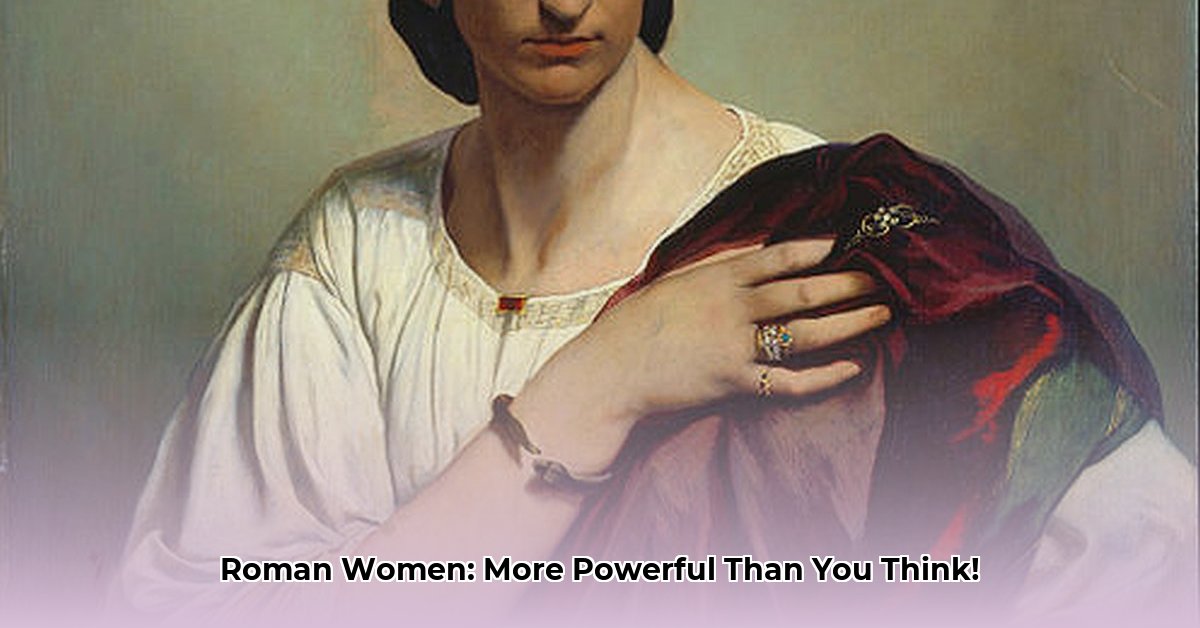Forget the simplistic images of the submissive Roman matron or the conniving empress. Women in ancient Rome, despite formidable legal and social limitations, carved out significant spheres of influence that profoundly shaped their families, communities, and even the political landscape. This article delves into the multifaceted lives of freeborn Roman women, exploring their daily realities, economic contributions, and the subtle yet potent ways they navigated a male-dominated society. We will critically examine Roman laws and customs, illuminate the profound importance of their roles in marriage and family, and highlight the undeniable impact of figures like Livia, Agrippina, and even less privileged women, whose stories have often been obscured by historical biases. Prepare to have your perceptions of women in ancient Rome thoroughly challenged and redefined. This is the authentic narrative of how they wielded power, even when the odds seemed insurmountable.
Untangling the Complex Lives of Women in Ancient Rome
For centuries, our understanding of women in ancient Rome has been largely filtered through the lens of male historians, poets, and politicians. This has often resulted in common archetypes: the virtuous, silent wife; the cunning, manipulative noblewoman; or the economically invaluable but historically invisible homemaker. However, a deeper, more critical examination reveals a far more complex and dynamic reality. It is crucial to look beyond these simplified narratives to uncover the genuine influence and diverse experiences of these women, not only within their private households but also in the broader societal and economic fabric of the Roman world.
Legal and Social Frameworks: Navigating a Man’s World
Roman freeborn women were indeed citizens ( cives ), yet this status conspicuously did not grant them fundamental political rights such as voting, holding public office, or speaking in assemblies. This legal exclusion undeniably constrained their public roles and opportunities. From a young age, often as early as their mid-teens, marriage and childbearing were considered paramount, frequently defining a Roman woman’s social standing and sometimes offering specific legal advantages. For much of Roman history, adult women were legally subject to patria potestas (the power of the father) or tutela mulierum perpetua (perpetual guardianship by a male guardian, usually their nearest male relative).
Despite these restrictions, Roman law allowed women, particularly those marrying sine manu (without the husband gaining legal control over her property), to own property, inherit wealth, and engage in business ventures. This meant that while they might not control their own legal decisions directly, they often had significant economic autonomy. For example, a woman could legally reclaim her own property following a divorce, which was relatively easy to obtain by either party in much of Roman history. However, children of the marriage legally belonged to the father. Later reforms, notably the Julian Laws introduced by Emperor Augustus around 18 BCE, offered some women, specifically freeborn mothers of three or more children (or four for freedwomen), exemption from male guardianship, granting them a degree of legal independence previously unattainable.
Diverse Roles and Enduring Responsibilities Across Social Strata
A Roman woman’s daily life and responsibilities varied dramatically based on her social class and wealth. Wealthy Roman women frequently managed elaborate households, overseeing vast finances, supervising numerous slaves, and, crucially, directing their children’s education in subjects ranging from literature to philosophy. They were the materfamilias, the mother of the family, and held considerable authority within their domestic sphere.
Women from the lower social strata, by contrast, often worked diligently outside the home to support their families financially. They engaged in a wide array of economic activities, demonstrating remarkable entrepreneurial spirit and resilience.
Consider the extensive professional and social opportunities available to Roman women:
- Household Manager ( Materfamilias ): Elite women held significant power in managing vast estates, finances, and slave populations, ensuring the smooth operation of large households.
- Shopkeeper/Trader: Many women from the plebeian and freed classes operated their own businesses, selling goods from food provisions to clothing, jewelry, and even luxury items in bustling Roman markets.
- Textile Worker: Spinning wool and weaving fabrics were common occupations across all social classes, from the elite overseeing slave labor to poor women earning a living.
- Agricultural Worker: In rural areas and on large estates, women labored alongside men in fields, contributing directly to food production and the agrarian economy.
- Midwife ( Obstetrix ): Given the inherent dangers of childbirth, midwives were indispensable, providing crucial medical assistance and post-natal care to women of all social standings.
- Priestess: Some women attained significant religious roles, most notably the Vestal Virgins, who maintained the sacred fire in the Temple of Vesta. They held immense prestige, legal autonomy, and sometimes even political influence, as when they interceded to save a young Julius Caesar from Sulla.
- Entertainer: A segment of women worked as dancers, musicians, and actresses, performing in public theaters and at private events, although these professions were often stigmatized.
- Wet Nurse ( Nutrix ): Wealthy families frequently employed wet nurses to breastfeed and care for their newborns, allowing biological mothers to focus on other societal or domestic duties.
- Hairdresser ( Ornatrix ): As personal grooming became increasingly elaborate, some women found employment as hairdressers, styling the complex coiffures of affluent Roman men and women.
- Prostitute ( Meretrix ): Prostitution was a prevalent, though often stigmatized, means of income for some women, ranging from those working in brothels to independent streetwalkers, often identifiable by wearing a toga instead of the traditional stola for respectable women.
- Scribe/Teacher: Highly educated women, or those from lower classes trained in literacy, could serve as scribes, secretaries, or even tutors for children.
Looking for more on the real lives of these women?
The Power They Wielded Beyond Expectations: Case Studies in Influence
Despite legal and social constraints, numerous Roman women discovered practical and strategic ways to exert significant influence. Figures like Livia Drusilla (58 BCE – 29 CE), the formidable wife of Emperor Augustus, or Agrippina the Younger (15–59 CE), the ambitious mother of Emperor Nero, undeniably held considerable sway over their powerful husbands and sons. These elite women strategically leveraged their familial connections and positions to affect social, economic, and even political decisions.
Livia, for instance, was not just Augustus’s devoted wife but also his trusted advisor and confidante, often influencing significant legislative and personal decisions. The historian Suetonius recounts that Augustus would meticulously compile lists of items on which he desired Livia’s input, counsel that frequently superseded that of his male advisors. Yet, her power often drew harsh criticism, with later historians like Tacitus portraying her as a “catastrophe to the nation” who poisoned rivals to secure her son Tiberius’s succession.
Agrippina the Younger similarly wielded immense influence, becoming the first Roman empress to receive the revered title of Augusta while her husband, Claudius, was still alive. She cannily maneuvered her son Nero to the throne and initially acted as his regent. However, as Nero matured, he grew resentful of her interference, eventually plotting her murder. The historical accounts, predominantly written by men like Tacitus and Suetonius, often depicted such powerful women as driven by “feminine rage” or “natural greed,” highlighting the prevailing male bias against women in authority.
Beyond the imperial court, other women left indelible marks. Cornelia Africana (c. 190–100 BCE), the celebrated mother of the Gracchi brothers, exemplified moral authority and intellectual prowess. Despite living centuries earlier, her influence on her sons’ populist reforms was profound. She famously referred to her sons as her “jewels,” and her letters guiding and sometimes chiding them illustrate a powerful, guiding hand in a politically turbulent era. Even after their assassinations, Cornelia retained widespread awe and respect for her learning and devotion to family and state.
Hortensia, daughter of the famous orator Quintus Hortensius Hortalus, defied expectations in 42 BCE by delivering a powerful speech in the Roman Forum. She eloquently argued against the triumvirate’s proposal to tax Rome’s wealthiest women to fund a war, demonstrating a rare public display of female oratorical skill and political resistance. Later, in the Imperial period, figures like Julia Domna (170-217 CE), wife of Septimius Severus, not only received the title of Augusta but was also a noted patron of the arts and philosophy, earning the impressive title of ‘mother of the senate and of the fatherland’.
The stories of women from outside the Roman elite also challenge the narrative of complete powerlessness. Boudicca, queen of the Iceni tribe in Roman Britain, led a fierce revolt against Roman occupation in 60/61 CE, demonstrating military leadership completely contrary to Roman norms for women. Her courage and defiance became a lasting symbol of resistance. Similarly, the tombstone of Regina, a freedwoman from Britain, honored by her Syrian husband, Barates, details her life as a respected wife, offering a rare glimpse into the lives of non-elite women and the blending of cultural identities in the Roman Empire. Even the philosopher Hypatia of Alexandria (c. 350-415 CE), though from a later period, stands as a testament to female intellectual leadership and influence.
Challenging Perceptions and Unearthing Truths
The predominantly male-authored historical record significantly shapes our contemporary understanding of women in ancient Rome. Therefore, effectively seeing beyond these entrenched biases requires a rigorous, critical examination of existing sources and an active search for the multifaceted narratives that lie beneath the surface. For instance, Roman naming conventions provide insight into their view of women; daughters almost always took a feminine version of their father’s family name (e.g., Julia for Gaius Julius’s daughter), with distinctions like “Major” or “Minor” for multiple daughters, rather than unique individual names. This practice underscores their value as extensions of the male line.
Historians are continually re-evaluating existing evidence, meticulously studying inscriptions on tombs (epitaphs often offer direct, though brief, insights into women’s lives), analyzing household artifacts, and re-interpreting literary texts to uncover hidden female perspectives. This critical approach is vital for reconstructing a more accurate and nuanced history, moving beyond simplistic stereotypes to appreciate the rich tapestry of Roman female experience.
Actionable Takeaways: Bringing Her Story to Light
How can we utilize this knowledge to transform the way we perceive and teach about women in ancient Rome? The overarching goal is to recognize the multifaceted roles and genuine influence of women, moving beyond simplistic narratives to unveil the vibrant complexity of their lives.
Here are concrete steps for various stakeholders:
- Educate: Encourage educators across all levels to incorporate a broader range of women’s stories, including those from diverse social classes and geographical locations within the Roman Empire, into their curricula. This will challenge conventional historical narratives and foster a more inclusive and accurate understanding of Roman society.
- Museums Can Help: Cultural institutions, especially museums and archaeological sites, should develop and feature exhibits that showcase the diverse roles women played in Roman society, highlighting their economic contributions, legal challenges, and personal lives, bringing their experiences to a broader public.
- Research Further: Historians and researchers must continue to conduct in-depth investigations, meticulously combining legal documents, epigraphic data (inscriptions), and archaeological discoveries to construct a more detailed and accurate picture of women’s lives, social networks, and direct and indirect influence. This includes analyzing the material culture of women’s daily lives—from cosmetics and jewelry to household implements and tomb art—to glean insights beyond written texts.
Here’s a breakdown of how key groups can contribute:
| Stakeholders | Action |
|---|---|
| Historians & Researchers | Utilize a wider array of diverse sources, including detailed epigraphic data, archaeological findings, and re-evaluated literary texts, to meticulously map women’s social networks, trace their economic activities, and analyze their direct and indirect influence on Roman society. |
| Educators | Develop and implement curricula that encourage students to critically analyze women’s roles, fostering nuanced discussions about gender, power dynamics, and social change within the Roman context, and encouraging source criticism. |
| Cultural Institutions | Partner with museums and other public venues to create engaging, traveling exhibits that showcase the multifaceted stories of women in ancient Rome, reaching diverse audiences beyond academic circles and presenting their lives through artifacts and interactive displays. |
Core Insights on Roman Women
This comprehensive re-examination of Roman women offers three pivotal insights that shatter conventional stereotypes:
- Agency within Constraints: Despite formidable legal and societal limitations, ancient Roman women skillfully exercised significant, often indirect, influence over their families, communities, and even political landscapes, demonstrating remarkable resilience and strategic ability.
- Class-Dependent Realities: A woman’s social class profoundly shaped her daily life, dictating her access to education, economic opportunities, legal standing, and even naming conventions, leading to vastly different and complex experiences across Roman society.
- Critical Historical Lens: The historical narratives, predominantly written by men and often reflecting their biases and social agendas, must be approached with a critical analytical lens. It is imperative to delve beyond these traditional sources to uncover the full, nuanced spectrum of women’s experiences and invaluable contributions to Roman civilization.
By embracing these nuanced perspectives and actively seeking out the unspoken stories, we can truly bring the untold narratives of ancient Roman women to light, enriching our understanding of one of history’s most fascinating civilizations and recognizing the indelible mark they left on society.
- Unveiling ancient roman busts: Values, history, & decor tips. - August 18, 2025
- Unlock Ancient Glamour: Roman Hairstyles, a Recreation Guide for Today’s Style Icons - August 18, 2025
- Rome’s Visual Legacy: Finding Authentic Ancient Rome Images and Pictures Today - August 18, 2025
















